RAF Restorarion Key
Restoring the RAF/Air Ministry Type D Morse Key ref:10F/7373
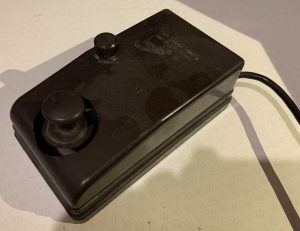
Figure 1: RAF Type D Morse Key as purchased
I bought this key, along with two others of the same type, from an Auction House in Newcastle in 2024. This one was in the best condition and complete, the other two had no interconnecting leads and one of those was missing the bakelite cover.
The Type D key was made by The Marconi Company and was a big ground station key with heavy duty replaceable contacts for use with high power RAF/Air Ministry transmitters both land based and those at sea. Because they were often used keying high voltages, the key is fully enclosed to protect the operator. Early versions have “ MARCONI’S WIRELESS TELEGRAPH Co Ltd. No xxxx LONDON inscribed on the base, later ones have unmarked bases. This example has an unmarked base and dates possibly from the 1970’s. (fig:1)
The key is made of brass and has adjustable contact spacing and spring tension. It is a precision design with zero side play. The 11m thick ebonite base has two through holes for hold-down screws and a hole for a threaded brass bush with knob for securing the bakelite cover. There are two holes for the cover locating pegs and the key has brass clamps for securing up to 8 cables. The key measures 101 x 90 x 183mm and weights about 1kg. The ref 10F/7373 is a UK Air Ministry Stores reference identity, originating from 1918 and in 1952 was replaced by the NATO Stock referencing system, for the Armed Services, which is a 13 digit NATO Stock Number (NSN) consisting of a 4 digit classification code (NSC) and a 9 digit National Item Identification Number (NIN). The first 2 digits of the NIN identify the country of origin (99 for UK).
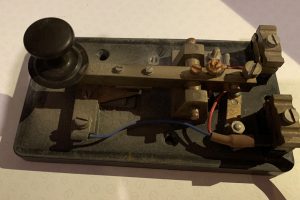
Figure 2: Key with cover removed
When starting a restoration, I always several photographs of the unit, with and without cover. (fig 2).
As I disassemble the key, I put groups of parts in small plastic bags which I then mark up with a number and short description. I annotate a picture where the part goes with the same number. By using this numbering system on disassembly; 1,2,3,….8 etc, I then know the order in which I need to assemble the parts when building the key back up.
This particular key was rather dirty and it was hard to tell that it was made of brass. To clean brass I use a metal polish with very fine steel wool, then clean off with cotton wool pads and give it a buff up with a “Dremel” fine brush. Some people would rather leave the “kay’s patina” as it is rather than “clean and polish it”. I respect this view, but I enjoy the knowledge gained from the disassembly and re-build because it forms more of an attachment with the key. Everyone to his own, I guess.
The disassembly was relatively straight forward. The ebonite base has a glass fibre board screwed in place which gave access to the key fixings when removed. The cover, base and key knob were washed in soapy water. There is a mark on the cover where the impressed key identity label is, that I couldn’t remove without resorting to stronger chemicals and I feared irretrievable damage if I experimented with it so I left it as is. I cleaned the brass parts as best I could and gave a light rub on the silver contacts with very fine steel wool. Some of the fixing screws and washers are steel and are showing signs of corrosion, I cleaned those up as best I could but decided not to replace them.
In common with armed service morse keys, there is the facility for connecting a SPACE contact which is normally closed when the key is at rest. (figure 6)
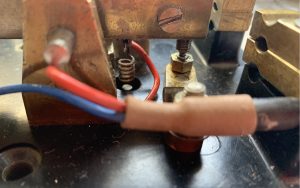
figure 6: SPACE contact at front of key
This was not wired into the jack plug fitted, which looks original and still has the On Her Majesty’s Service Label attached. It cleaned up rather well and I felt it was worth the effort. I don’t know whether to keep this key. It was the best of three identical keys that I purchased and one of those doesn’t have a cover so that one should be sold on at least. Compared to my Marconi Nato key I find that it feels less comfortable to use in long QSOs and I already have a nice Kent brass key that was my favourite SK before the Nato key along. I think if I was to sell the RAF Type D key I have just restored I could get around £90+ for it on EBay. Ones with damaged covers seem to regularly reach £70. ( I have signed up for MKA (Morse Keys Anonymous).
“ Hello my name is Chris and I am addicted to buying morse keys!”.
73
Chris G0EYO
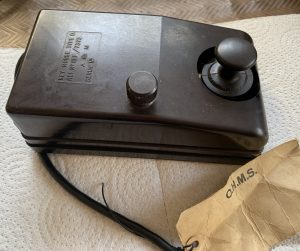
Restored RAF Type Morse D key
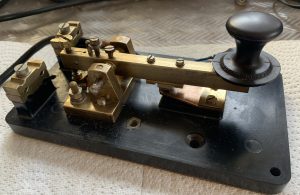
Key after clean up and restoration
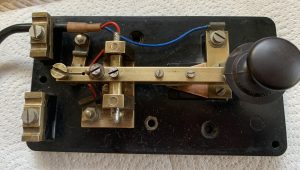
Key after restoration : top view
COMING SOON:
TUESDAY 1ST APRIL : OPEN COMMITTEE MEETING -8.00
THURSDAY 17TH APRIL-MONDAY 21ST APRIL: THE GREAT WYTHALL RADIO CLUB EASTER CONTEST
FRIDAY 18TH APRIL: FRIDAY MORNING CLUB 9.45-11.45 (OR POSSIBLY EXTENDED FOR WORLD AMATEUR RADIO DAY?)

